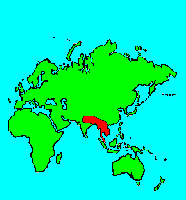SPECIES INFO
Williams mouse deer (Tragulus williamsoni) is native to northern Thailand. There appears to be only one known example, and this large mouse deer could be a larger form of T. kanchil.Mouse-deer (genus Tragulus) are a group of tiny deer that have short front legs and longer rear legs. There are between 2 and 6 species in this genus depending upon various opinions. The genus Tragulus is found in South Eastern Asia and south into Indonesia. These deer weigh less than a normal house cat and lack antlers. Two tentative species separated from T. javanicus are T. williamsoni found west of the Mekong River and T. kanchil found east of the Mekong River.
Chevrotains (Tragulidae Family) as of around 1984 contained four different species of rabbit-sized animals . However, in the Wilson-Reeder mammal list published in 2005, they now count 8 species. There is a close relationship between the family Tragulidae and the family Moschidae. The Chevrotains are among the smallest hoofed animals.
Pigs, Camels, Sheep, Oxen, Antelopes, and Deer and many other large mammals are combined into a single large group, Order Artiodactyla. Characteristically, the feet of these animals have modified into hoofs with two toes. Several major families belong here including:
Bovidae - Cattle, Sheep, Goats, and Antelopes
Camelidae - Camels and Llamas
Cervide - Deer, Elk, Moose
Giraffidae - Giraffe and Okapi
Suidae - Pigs
Mammals (Class Mammalia), together with the birds, are among the youngest of the classes of animals. In species count, mammals number about fifty-one hundred, trailing reptiles (approximately fifty-five hundred), fish (approximately eighteen thousand), and birds (approximately eighty-six hundred).
There are three sub-types of mammals:
monotremes, the most primitive:
Develop in reptilian-like eggs and suckle milk emerging
(i.e., spiny anteater, duckbilled platypus)
marsupials
Newborn emerges very underdeveloped and continue to
mature in a pouch on its mother's abdomen (i.e., opossums,
koala, kangaroo)
placental
Embryo develops within the uterus of the female and is
dependent on a placenta for nutrition and waste removal
(i.e., humans, lions, monkeys)
About sixty-five million years ago, the Tertiary era produced thirty-five orders of mammals. Of this number, eighteen have survived to represent Earth's most diversified as well as its most highly developed classification of animals.
Extinction of mammals is fast becoming a serious issue. Duff and Lawson present a list of forty-one extinct species that reached extinction prior to 1800. These forty-one species are not acknowledged in the counts of the various families. Duff and Lawson also present a list of forty-six species including three gazelles, one zebra, one seal, one deer, and one wolf that have probably gone extinct since 1800. These forty-six species are included in the family counts. Science is adding about forty to fifty new species a year to the list. Many of these are the result of divisions of prior species; some are recent discoveries.
Mammals owe their survival to adaptive capabilities that include the ability to exploit whatever sources of food are available to them, as well as their ability to adjust to various climes. Food specialization influenced evolution to such a great extent that the teeth structure can and has been used to provide extensive information on the food needs and various lifestyles of extinct species.
Despite the vast diversity among mammals in terms of size, habitats and adaptations, they share without exception many characteristics such as:
a. body hair
b. mammary glands
c. certain skull characteristics
d. four limbs that permit speed
e. parallel not perpendicular limbs
f. compartmentalized internal organs
g. a four-chambered heart and pulmonary circulation
Backboned Animals (Phylum Chordata) are the most advanced group of animals on earth. These animals are characterized by having a spinal cord or backbone. Most members have a clearly defined brain that controls the organism through a spinal cord. Fish, amphibians, reptiles, birds, and mammals are in this phylum.
Currently, some taxonomists believe that the fish should be divided into two groups (sharks and regular fishes) and that there are some other primitive groups in the phylum such as hagfish or lampreys.
Animal Kingdom contains numerous organisms that feed on other animals or plants. Included in the animal kingdom are the lower marine invertebrates such as sponges and corals, the jointed legged animals such as insects and spiders, and the backboned animals such as fish, amphibians, reptiles, birds, and mammals.

